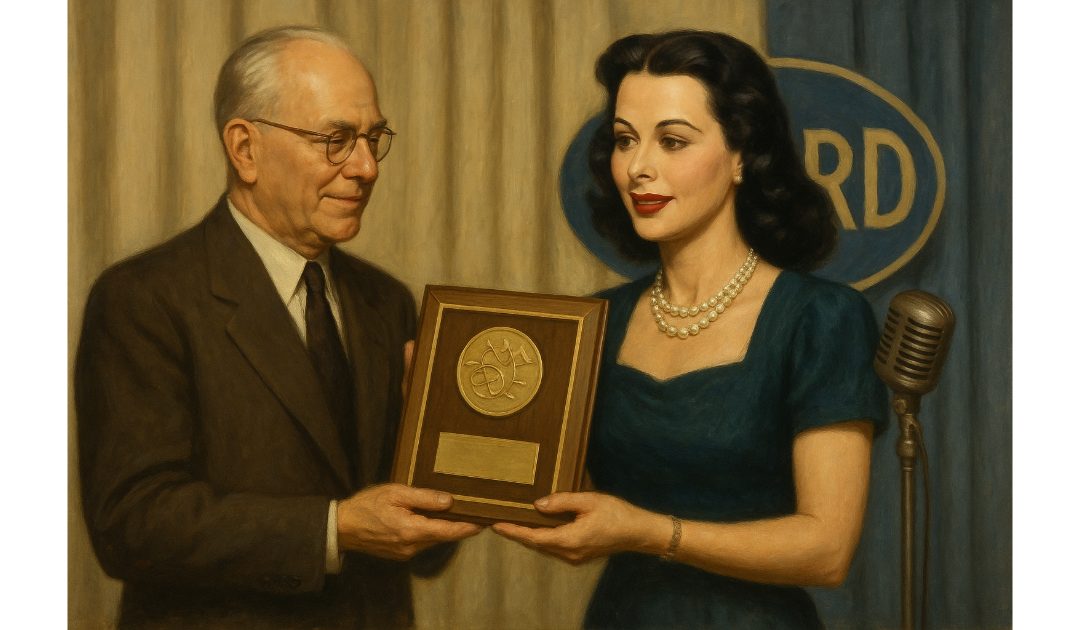On the 11th of August, 1942, the actress Hedy Lamarr and the composer George Antheil were granted a patent for a frequency hopping, spread-spectrum communication system that later became the basis for modern technologies in wireless telephones, two-way radio communications, and Wi-Fi. I’ve posted about performers and inventors, but Lamarr is the only person I can think of that fits both categories.
Hedy Lamarr, born Hedwig Eva Maria Kiesler on the 9th of November, 1914, in Vienna remains an iconic figure celebrated not only for her illustrious acting career but also for her groundbreaking work in technology. Lamarr’s life was a tapestry woven with glamour, intellect, and an indomitable spirit that defied the conventions of her time.
Raised in an affluent Jewish family, Lamarr showed early signs of brilliance. Her father, Emil Kiesler, instilled in her a curiosity about how things worked, often discussing the inner mechanics of machinery during their walks. This foundational interest in technology would later lead to significant contributions in the field of wireless communication.
Lamarr’s beauty was evident from a young age, propelling her into the world of cinema. She gained international attention with her role in the 1933 film Ecstasy, controversial for its candid portrayal of female sexuality. This performance caught the eye of Louis B. Mayer of MGM, who brought her to Hollywood and rebranded her as Hedy Lamarr. She soon became one of the most glamorous stars of the Golden Age of Hollywood, starring in films such as Algiers (1938), Ziegfeld Girl (1941), and Samson and Delilah (1949).
However, Lamarr’s talents extended far beyond the silver screen. During World War II, disturbed by the Axis powers’ ability to jam Allied torpedoes, Lamarr collaborated with composer George Antheil to develop a frequency-hopping spread spectrum technology. This invention was designed to make radio signals more secure, reducing the risk of interception or jamming. They achieved this by synchronising frequency changes between the transmitter and receiver, akin to musical notes shifting in a sequence, inspired by Antheil’s background in music.
Lamarr and Antheil received a patent for their invention in 1942. Although the U.S. Navy did not adopt the technology during the war, dismissing it as impractical, the principles behind their work later became foundational for advanced communication systems. Their invention paved the way for modern technologies such as Wi-Fi, Bluetooth, and GPS, underscoring Lamarr’s role as a pioneer in the digital age.
Despite her scientific achievements, Lamarr faced significant challenges in gaining recognition. The gender biases of the era often relegated her to the role of a glamorous actress, overshadowing her intellectual pursuits. Additionally, she did not earn financial benefits from her patent, as it had expired by the time its applications were fully realised in modern technology.
Lamarr’s personal life was as dynamic as her career. She married six times, each relationship reflecting her quest for companionship and understanding. Her autobiography, Ecstasy and Me, published in 1966, detailed her tumultuous relationships and complex persona, though Lamarr later disavowed the book, claiming it misrepresented her.
In her later years, Lamarr retreated from public life, choosing seclusion over the spotlight. However, recognition for her scientific contributions grew posthumously. In 1997, she received the Electronic Frontier Foundation’s Pioneer Award, acknowledging her role in the development of secure communications. In 2014, she was inducted into the National Inventors Hall of Fame, solidifying her legacy not just as a star of the screen but as a trailblazer in technology.
Hedy Lamarr passed away on the 19th of January, 2000, in Florida, USA, at the age of 85. Her ashes were spread in the Vienna Woods, fulfilling her wish to return to the country of her birth.
Lamarr’s life story continues to inspire, embodying the fusion of beauty, brains, and resilience. She defied the stereotypical roles assigned to women in both Hollywood and the scientific community, demonstrating that intellect and glamour are not mutually exclusive. Her contributions to technology highlight the often-overlooked achievements of women in STEM fields, encouraging future generations to pursue their passions regardless of societal expectations.
Hedy Lamarr remains a symbol of ingenuity and perseverance. Her legacy transcends the boundaries of film and science, reminding us that true brilliance can shine through in the most unexpected ways.

